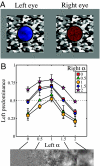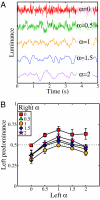Natural images dominate in binocular rivalry
- PMID: 19289828
- PMCID: PMC2663995
- DOI: 10.1073/pnas.0812860106
Natural images dominate in binocular rivalry
Abstract
Ecological approaches to perception have demonstrated that information encoding by the visual system is informed by the natural environment, both in terms of simple image attributes like luminance and contrast, and more complex relationships corresponding to Gestalt principles of perceptual organization. Here, we ask if this optimization biases perception of visual inputs that are perceptually bistable. Using the binocular rivalry paradigm, we designed stimuli that varied in either their spatiotemporal amplitude spectra or their phase spectra. We found that noise stimuli with "natural" amplitude spectra (i.e., amplitude content proportional to 1/f, where f is spatial or temporal frequency) dominate over those with any other systematic spectral slope, along both spatial and temporal dimensions. This could not be explained by perceived contrast measurements, and occurred even though all stimuli had equal energy. Calculating the effective contrast following attenuation by a model contrast sensitivity function suggested that the strong contrast dependency of rivalry provides the mechanism by which binocular vision is optimized for viewing natural images. We also compared rivalry between natural and phase-scrambled images and found a strong preference for natural phase spectra that could not be accounted for by observer biases in a control task. We propose that this phase specificity relates to contour information, and arises either from the activity of V1 complex cells, or from later visual areas, consistent with recent neuroimaging and single-cell work. Our findings demonstrate that human vision integrates information across space, time, and phase to select the input most likely to hold behavioral relevance.
Conflict of interest statement
The authors declare no conflict of interest.
Figures




References
-
- Geisler WS. Visual perception and the statistical properties of natural scenes. Annu Rev Psychol. 2008;59:167–192. - PubMed
-
- Mante V, Frazor RA, Bonin V, Geisler WS, Carandini M. Independence of luminance and contrast in natural scenes and in the early visual system. Nat Neurosci. 2005;8:1690–1697. - PubMed
-
- Brunswick E, Kamiya J. Ecological cue validity of ‘proximity’ an other Gestalt factors. Am J Psych. 1953;66:20–32. - PubMed
-
- Elder JH, Goldberg RM. Ecological statistics of Gestalt laws for the perceptual organisation of contours. J Vis. 2002;2:324–353. - PubMed
-
- Maloney LT. Evaluation of linear models of surface spectral reflectance with small numbers of parameters. J Opt Soc Am A. 1986;3:1673–1683. - PubMed
Publication types
MeSH terms
Grants and funding
LinkOut - more resources
Full Text Sources

